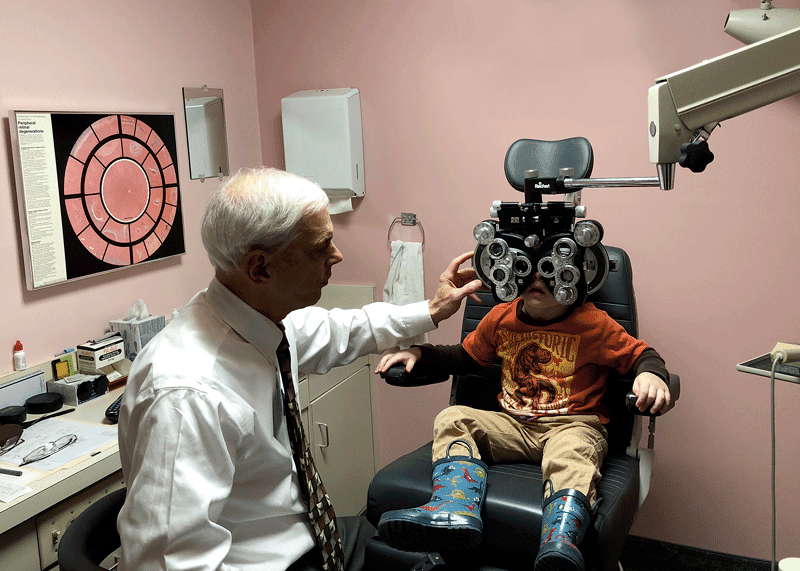Seeing the Light – Myopia Is on the Rise, and Screens May Be to Blame

Dr. David Momnie was on a plane recently, sitting near a woman who dialed up a movie on her phone and stared at the screen for two hours. He doesn’t recall her looking up until it was over.
“That’s not good,” he said, but it’s far from rare. In fact, close-up viewing of electronic screens, whether to examine data on a computer at work or to watch YouTube videos or play mobile games on a smartphone, has become such common practice that the eye-care community is increasingly citing the trend to explain a troubling rise in myopia.
About 40{06cf2b9696b159f874511d23dbc893eb1ac83014175ed30550cfff22781411e5} of the population is nearsighted, a problem that often develops in adulthood, but for children and teenagers, the number in the U.S. is more than 30{06cf2b9696b159f874511d23dbc893eb1ac83014175ed30550cfff22781411e5} and increasing, while in Singapore, South Korea, and China, the myopia rate across all age groups is approaching 90{06cf2b9696b159f874511d23dbc893eb1ac83014175ed30550cfff22781411e5} in some urban areas.
“It’s a huge problem, and in Asian countries, it’s a growing concern,” said Momnie, president of Chicopee Eye Care. “It’s a global phenomenon. But where is it coming from?”
Part of the issue is, and always has been, genetic, he explained — nearsighted parents pass on a predisposition to the condition to their children. “But that doesn’t explain the rapid increase in the past 30 years. It’s increased so rapidly that it’s got to be about more than genetics.”
Increasingly, doctors are saying the screen culture bears some blame.
“Kids are looking at computers at a very early age — iPhones, iPads, and computers — more and more,” he told HCN. “When I was a kid, when we were in the car, we played the license-plate game. Now, kids are on their phones or watching a movie on long trips. They’re getting three, four, five hours a day, or even more, of intense, concentrated near-point work, staring at a small screen eight inches away.”
Myopia, or nearsightedness, is a vision condition in which people can see close objects clearly, but objects farther away appear blurred. For example, people with myopia can have difficulty clearly seeing a movie or TV screen across a room, or the whiteboard in school.
According to the American Optometric Assoc. (AOA), people who have jobs or frequently engage in activities that require looking at something close up for long periods of time are at more of a risk of developing myopia. One such activity is screen time. Some people have even reported experiencing what is called ‘pseudo-myopia’ from staring at a computer or phone screen for too long. In short, they will develop all the effects of myopia, but for a short amount of time. As for permanent myopia, the only way to correct it is with glasses, contacts, or eye surgery.
A team from the University of Utah recently examined myopia’s rising tide and also pointed a finger at screens. They noted that, in 1984, 15{06cf2b9696b159f874511d23dbc893eb1ac83014175ed30550cfff22781411e5} of children had access to a computer at home. Now, more than 80{06cf2b9696b159f874511d23dbc893eb1ac83014175ed30550cfff22781411e5} of households in the U.S. have one, and most families have smartphones as well. While these technologies have various uses, from entertainment to education, they note, they also raise questions regarding proper usage and boundaries for children.
“There’s a lot more to this — pardon the pun — than meets the eye,” said Dr. Steven Squillace, an optometrist who practices at Somers Vision Clinic. He specializes in children and adults with eye-muscle and focusing problems, and has studied at length the effects of computers on the eyes.
“One of the hardest things in medicine is to make people make lifestyle changes, whether it’s smoking or high blood pressure or weight loss — or the amount of time they spend on devices like cell phones, tablets, or even laptop or desktop computers,” Squillace said. “With the evolution of the work world, more people have jobs that require employees to be on these devices, and the blue light emitted from the devices can be harmful.”
Doctors can do only so much, he added. Bifocals with blue filters and anti-glare properties filter off some of the blue light, “but it can still potentially damage the anatomy in the eye lens and macula over time.”
Close View of the Facts
While the exact cause of myopia is unknown, the genetic component is well-known. In fact, Momnie said, nearsightedness is the result of a complicated interaction between genetic predisposition and environmental exposures.
But those exposures can be significant. He cited a 1983 study on military recruits in Holland — well before computers and other devices were a ubiquitous part of life. But this study suggested the potential damage of long-term, close-up viewing of, well, anything. Specifically, 2{06cf2b9696b159f874511d23dbc893eb1ac83014175ed30550cfff22781411e5} of recruits who came from a farming background were nearsighted, 15{06cf2b9696b159f874511d23dbc893eb1ac83014175ed30550cfff22781411e5} with a merchant background had myopia, and 32{06cf2b9696b159f874511d23dbc893eb1ac83014175ed30550cfff22781411e5} of those with advanced education suffered from the condition.
“So we know that people who do a lot of near-point work have a higher incidence of nearsightedness than people who work outdoors in construction, farming, and other activities,” he added.
In a more recent study, researchers in Italy recruited 320 3- to 10-year-olds and tracked how long the children spent in front of screens each day. They found that kids who spent more than 30 minutes a day playing video games were more likely than the others to suffer from headaches, eyelid tics, double vision, and dizziness, while 90{06cf2b9696b159f874511d23dbc893eb1ac83014175ed30550cfff22781411e5} of the frequent video-game players had refractive vision problems such as myopia or farsightedness, particularly in their dominant eyes, compared with only half of the less-frequent players.
The World Health Organization predicts that, if current trends continue, half the world’s population will be myopic by 2050, and one-fifth of those will be at a significantly increased risk of blindness. And the WHO isn’t alone in its worry. “The AOA has long been concerned about the increased incidence of myopia and the impact of the increased visual stress caused by digital eye strain,” said Andrea Thau, the AOA’s immediate past president.
The AOA strongly encourages children to participate in outdoor activities and to follow the 20-20-20 rule: for every 20 minutes of reading, computer, or close work, take a 20-second rest break by looking at things at least 20 feet away. Thau, who has a primary-care practice with special emphasis on children’s vision and vision therapy in Manhattan, advises that doctors of optometry encourage young patients to engage in eye-hand coordination activities and to play sports and other outdoor activities.
Momnie agrees with the 20-20-20 philosophy. “It just refocuses the eyes, and it’s a reminder that prolonged staring at a short distance is a strain on the eyes.”
The AOA issued several other tips on screen use to protect eyesight. First, the user should be in a comfortable position when using a computer or any digital screen, sitting up straight with a flat back and forearms resting comfortably on the desk or table. The screen should be held away from the face and viewed at a slight downward angle. Other light sources should be minimized, to avoid glare on the computer screen, which can cause extra strain on the eyes. And users should consciously blink often, because staring at any light source can cause eyes to dry up faster and actually inhibit the urge to blink. If dry eyes are a particular problem, eye drops may be used periodically.
Another area of concern for the ADA is addictive screen use. The organization advises parents to establish clear rules when it comes to video-game use in particular, including both time limits and conditions such as being able to play only after all homework is completed. And it’s not just eyesight at risk; a recent German study suggests that overuse of electronic media by children is reducing their overall sleep quality.
“So, how do we stop it?” Momnie asked, before suggesting that a lifestyle that gets kids back outside could be a good start. “Studies have shown that being outdoors two hours a day causes a significant reduction in nearsightedness. In Singapore, they’re redesigning classrooms to let more light in, and making more time for outdoor recess.”
However, many American school districts, especially in the middle- and high-school years, are now requiring students to complete and submit their homework digitally, perhaps increasing their susceptibility to early-onset myopia.
Whatever the reason, the condition’s increasing prevalence among children could contribute to learning deficiencies as they struggle in school but don’t know why. “Eighty percent of learning is visual,” he said, “and they may not know they’re nearsighted.”
Digital Breaks
As for adults, Momnie went on, two decades ago, most people staring at a computer screen for eight hours were in financial services — such as banking and accounting — and perhaps customer service. Today, more and more jobs have fallen under the umbrella of heavy screen time.
Squillace said many employers, as an ergonomic measure, are encouraging employees to take ‘digital breaks’ by simply looking away from the screen for a half-hour, perhaps getting up to grab a cup of water and look out the window.
“There’s some value in that, not having the eye engaged for hours on end. You really need to take those visual breaks,” he told HCN. “When we talk about limiting activity, it’s more managing it, taking those breaks, and mixing it up. Get off the screen and do some pencil-and-paper tasks. Do some math homework on traditional paper instead of working on a computer.”
At the very least, adults can set an example for their children in the way they handle their own screen time, Momnie said. And it’s OK to be firm.
“Parents can say, ‘you’re allowed one hour a day, and then you have to spend an hour or two outdoors.’ Kick them outdoors during the weekends, and they probably shouldn’t play on their devices during the evening. And for kids under 2, don’t even let them near one of these things. Even a video game on TV is better than looking at an iPhone or iPad.”
After all, he said, parenthood is a benevolent dictatorship, not a democracy.
“Computers aren’t going away, and trying to keep kids off computers isn’t easy to do,” he admitted. But preventing nearsightedness — or at least pushing it well into the distance — makes the effort worthwhile.


Comments are closed.